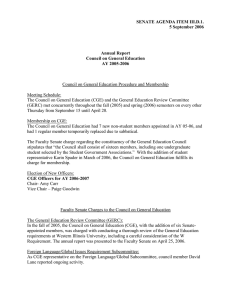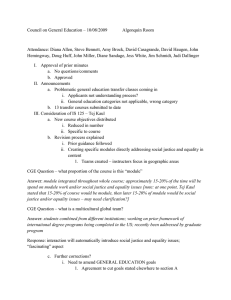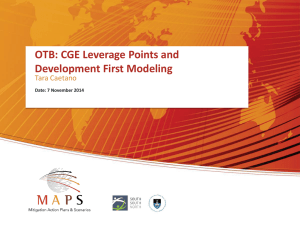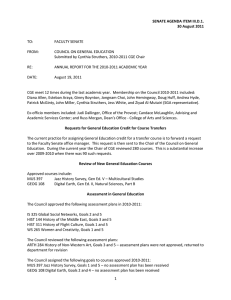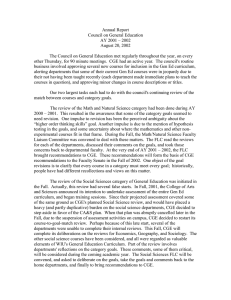First Draft Please do not quote Notes on Dynamics in CGE Models
advertisement
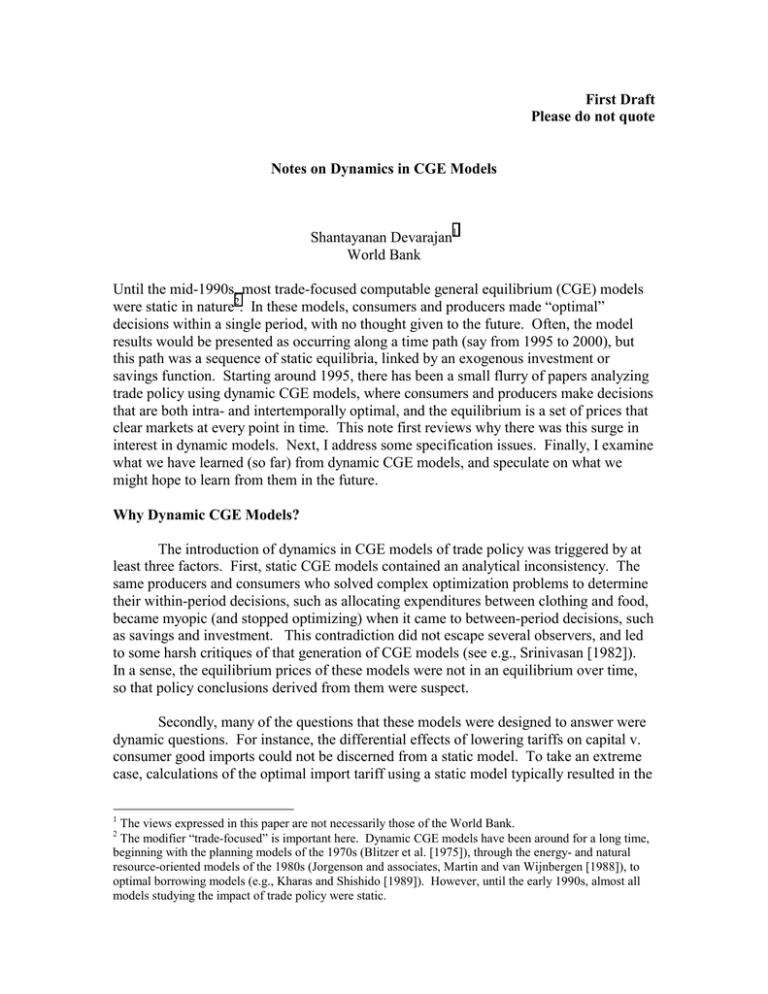
First Draft Please do not quote Notes on Dynamics in CGE Models Shantayanan Devarajan1 World Bank Until the mid-1990s, most trade-focused computable general equilibrium (CGE) models were static in nature2. In these models, consumers and producers made “optimal” decisions within a single period, with no thought given to the future. Often, the model results would be presented as occurring along a time path (say from 1995 to 2000), but this path was a sequence of static equilibria, linked by an exogenous investment or savings function. Starting around 1995, there has been a small flurry of papers analyzing trade policy using dynamic CGE models, where consumers and producers make decisions that are both intra- and intertemporally optimal, and the equilibrium is a set of prices that clear markets at every point in time. This note first reviews why there was this surge in interest in dynamic models. Next, I address some specification issues. Finally, I examine what we have learned (so far) from dynamic CGE models, and speculate on what we might hope to learn from them in the future. Why Dynamic CGE Models? The introduction of dynamics in CGE models of trade policy was triggered by at least three factors. First, static CGE models contained an analytical inconsistency. The same producers and consumers who solved complex optimization problems to determine their within-period decisions, such as allocating expenditures between clothing and food, became myopic (and stopped optimizing) when it came to between-period decisions, such as savings and investment. This contradiction did not escape several observers, and led to some harsh critiques of that generation of CGE models (see e.g., Srinivasan [1982]). In a sense, the equilibrium prices of these models were not in an equilibrium over time, so that policy conclusions derived from them were suspect. Secondly, many of the questions that these models were designed to answer were dynamic questions. For instance, the differential effects of lowering tariffs on capital v. consumer good imports could not be discerned from a static model. To take an extreme case, calculations of the optimal import tariff using a static model typically resulted in the 1 The views expressed in this paper are not necessarily those of the World Bank. The modifier “trade-focused” is important here. Dynamic CGE models have been around for a long time, beginning with the planning models of the 1970s (Blitzer et al. [1975]), through the energy- and natural resource-oriented models of the 1980s (Jorgenson and associates, Martin and van Wijnbergen [1988]), to optimal borrowing models (e.g., Kharas and Shishido [1989]). However, until the early 1990s, almost all models studying the impact of trade policy were static. 2 highest tariff being on capital good imports, because that was the closest thing to a lumpsum tax in these models. Increases in the capital import tariff only lowered investment, which had no welfare effects since the capital stock was fixed (Dahl et al. [1993]). Plainly, to answer the most important questions of trade policy, a dynamic model was needed. Thirdly, static modelers were faced with a dilemma. Despite overwhelming theoretical and reasonably strong empirical evidence on the benefits of trade liberalization, most static CGE models showed that the welfare gains of eliminating tariffs were less than one percent of GDP (see e.g. Srinivasan and Whalley [1986]). This was potentially embarrassing, especially since a series of major trade liberalization exercises (the Uruguay Round, NAFTA, etc.) had already started using CGE models to underpin their programs. One reason for the low welfare gains, it was thought, was that most of these models were static, and hence did not capture the “dynamic gains” from trade liberalization. Some tried to show this by assuming that trade liberalization will lead to faster productivity growth, thereby amplifying the gains, but these efforts came under the obvious criticism. Consequently, several people (Delfin Go and myself included) set about building dynamic CGE models to test the proposition that the welfare gains from trade liberalization will be greater in these models than in the static models. As we will see later, they were to be disappointed, but before examining results from these models, we address some issues relating to their specification. Making CGE Models Dynamic The task of taking a static CGE framework and making the model dynamic is both straightforward and subtle. On the one hand, it amounts to adding a time subscript to all prices and demand and supply functions of the static model. Consumers and producers therefore are making optimal decisions based not just on current prices, but on all future prices as well. On the other hand, as this discussion would indicate, the model needs to be simplified along a number of dimensions for it to be tractable. First, we assume the consumer’s utility function is separable across time, so that he maximizes the present value of the utility of aggregate consumption, subject to an intertemporal budget constraint. Similarly, we assume producers maximize the value of the firm (equal to the present value of net income). While both of these specifications simplify the general-equilibrium problem, the model is still high-dimensional, which is why the sectoral disaggregation is typically quite limited (with the extreme version of two sectors in Devarajan and Go [1998]). Second, since the model cannot be solved for an infinite number of periods, we need to specify the post-terminal conditions. The standard approach is to assume that the economy will be in a steady-state after the terminal period, T. Typically, this steady state is defined by an exogenous growth rate, g*. If T is sufficiently far into the future, the choice of g* does not affect the behavior of the model in the early years (which are usually the years of interest for simulations). However, if it is assumed that g* is not exogenous, but rather is a function of policies undertaken during the period before T, then of course this specification has an important effect on the outcome both before and after T. Put another way, if g* is exogenous, the effect of trade liberalization, say, will be somewhat limited, since the economy’s steady-state growth rate will not have changed as a result of the policy reform (although the level of income at which it reaches the steady state will be different). The welfare gains from trade reform will be muted. By contrast, if g* is affected by the trade liberalization, the welfare gains will be amplified, since the economy not only adjusts to the trade reform before T, but enjoys a higher long-term growth rate forever. Third, in any dynamic model, there is a level of the capital stock that satisfies some version of the “golden rule.” For instance, if the economy can borrow from abroad at a given interest rate r, then this capital stock is that which makes the marginal product of capital equal to r. When such models are solved numerically, there is a tendency for the economy to jump as fast as possible to this level of capital; the models exhibit “bangbang” behavior. Since such behavior is not observed in the real world, and could make the model results implausible, modelers tend to impose an adjustment cost function that dampens the bang-bang behavior. For instance, it is assumed that there is a cost to investment that is quadratic in the ratio of investment to capital stock. Such a specification leads to the economy adjusting to the desired capital stock in a smooth fashion over time. While there are several other issues in building dynamic CGE models, the above three are probably the most important. Furthermore, they are useful in interpreting the results of dynamic models, the subject to which we now turn. Results from Dynamic CGE Models As mentioned earlier, one of the reasons for building dynamic CGE models was to investigate whether these models gave larger welfare gains from trade liberalization than their static counterparts. We will now see if they did. I will not survey the literature. Rather, I will select a few results to illustrate the main points that seem to be emerging. Before proceeding to the results from dynamic models, it is worth recalling why the static models gave such small welfare gains from trade reform. The main reason was that trade taxes were but one of many distortions in the economy. From second-best welfare economics, we know that removing one distortion in such an economy need not lead to a welfare gain. In fact, the compensating distortions with trade were acting as to dampen the welfare gains from trade liberalization. The main conclusion from some of the dynamic CGE models is that the same reasoning applies to the dynamic case. That is, the dynamic CGE models also contain multiple distortions, so that removing trade taxes (and replacing them with lump-sum taxes), even with endogenous investment and savings decisions, does not significantly amplify the welfare gains from trade liberalization. One example is Devarajan and Go’s [1998] model of the Philippines, where trade liberalization yielded a welfare improvement of 0.1167 percent. While comparisons with static models are problematic, this figure does represent an increase over the welfare improvement from a static model, which showed the welfare gain to be only 0.004 percent. Similarly, Rutherford and Tarr [2001] obtain a welfare gain of 0.5 percent in their “constant returns to scale” version of a 54-sector dynamic CGE model. These results stand in some contrast to the results obtained in other dynamic models, such as Francois, MacDonald and Nordstrom [1996]. In an extremely useful paper, Rutherford and Tarr [2001] use a model of Chile to understand the differences between the two sets of models. They point out that the approach taken by Francois et al. [1996] essentially involves adjusting the steady state growth rate of the economy in response to the trade liberalization. The improved resource allocation from trade reform will lead to an increase in the rate of return to capital. Francois et al. calculate the size of the new capital stock resulting from additional investment as the marginal productivity of capital returns to its long-run equilibrium level. As Rutherford and Tarr point out, the Francois et al. calculation does not include the consumption forgone in obtaining the larger capital stock, nor do they model the dynamics of the transition to the new steadystate. They conclude therefore that the Francois et al. results represent an upper bound on the potential welfare gains from trade liberalization. Finally, Rutherford and Tarr do obtain significant welfare gains from trade liberalization in their 54-sector model (a 10 percent tariff cut leads to a 10 percent welfare gain), but it is due to their modeling of increasing returns and product variety, not to dynamics. As they show, when they assume constant returns to scale (and hence no increase in product variety from liberalization), the gains are less than 0.5 percent. Hence, this highly selective review of a few dynamic CGE models indicates that dynamics alone will not lead to appreciably higher welfare gains from trade liberalization. The big welfare gains seem to be coming from increases in product variety and increasing returns to scale, something which can be modeled without dynamic models. That is not to say, however, that dynamic CGE models are not useful. On the contrary, as pointed out earlier, some of the most important questions require a dynamic model for their analysis, and the fully-specified dynamic model is a necessary starting point. Furthermore, as many of us have learned, even when they give disappointing aggregate welfare results, these dynamic models provide rich insights on the intertemporal behavior of consumption, investment, exports and imports. Given that the costs of building such models have come down, the net benefit of making CGE models dynamic is clearly positive, and possibly quite large.
